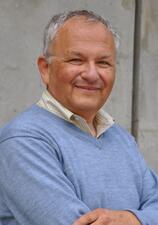Current BPS Faculty

Mary Lu Arpaia
phone (559) 646-6561
email marylu.arpaia@ucr.edu
Botany and Plant Sciences Dept
Contact Info:
Title: Cooperative Extension Specialist, Subtropical Horticulture
CE -Botany and Plant Sciences
Tel: (559) 646-6561
E-mail: marylu.arpaia@ucr.edu

Julia Bailey-Serres
phone (951) 827-3738
email julia.bailey@ucr.edu
Mechanisms that enable crops to be resilient to floods and other climate change stresses,Mechanisms of gene activity control from chromatin to the translated mRNA, Technologies that enalble analysis of gene regulation in specific populatoins of cells
Contact Info:
Title: Distinguished Professor and Geneticist
Tel: (951) 827-3738
E-mail: julia.bailey@ucr.edu
https://profiles.ucr.edu/julia.bailey
Member of the UC ANR – UC Agricultural Experiment Station

James Baird
phone (951) 827-5630
email james.baird@ucr.edu
Botany and Plant Sciences Dept
Contact Info:
Title: Professor
CE -Botany and Plant Sciences
Tel: (951) 827-5630
E-mail: james.baird@ucr.edu
https://profiles.ucr.edu/james.baird
Member of the UC ANR – UC Agricultural Experiment Station

Christopher Catano
phone (951) 827-1723
Contact Info:
Title: Assistant Professor
Botany & Plant Sciences
Tel:
E-mail: christopher.catano@ucr.edu
https://profiles.ucr.edu/christopher.catano
Member of the UC ANR – UC Agricultural Experiment Station

Meng Chen
phone (951) 827-5635
email meng.chen@ucr.edu
Light and temperature signaling in plants
Contact Info:
Title: Professor and Cell Biologist
Botany and Plant Sciences
Tel: (951) 827-5635
E-mail: meng.chen@ucr.edu
https://profiles.ucr.edu/app/home/profile/mengc
Member of the UC ANR – UC Agricultural Experiment Station

Sean Cutler
phone (951) 827-6990
email sean.cutler@ucr.edu
Plant Biology, Chemical Biology, Molecular Genetics, Biotechnology
Contact Info:
Title: Distinguished Professor and Plant Cell Biologist
Botany and Plant Sciences
Tel: (951) 827-6990
E-mail: sean.cutler@ucr.edu
https://profiles.ucr.edu/app/home/profile/cutler
Member of the UC ANR – UC Agricultural Experiment Station

Katayoon Dehesh
phone (951) 827-6370
email katayoon.dehesh@ucr.edu
Contact Info:
Title: Distinguished Professor and Molecular Biochemist
Botany and Plant Sciences
Tel: (951) 827-6370
E-mail: katayoon.dehesh@ucr.edu
https://profiles.ucr.edu/katayoon.dehesh
Member of the UC ANR – UC Agricultural Experiment Station

Ashraf El Kereamy
phone (951) 827-2280 | 559-592-2408 Ext. 1154
email ashraf.elkereamy@ucr.edu
Contact Info:
Title: Associate Professor of Cooperative Extension
CE-Botany and Plant Sciences
Tel: (951) 827-2280 | 559-592-2408 Ext. 1154
E-mail ashraf.elkereamy@ucr.edu
https://profiles.ucr.edu/ashraf.elkereamy

Maria Florencia Ercoli
phone
email mariaflorencia.ercoli@ucr.edu
Contact Info:
Title: Assistant Professor
Botany and Plant Sciences
Tel:

Thomas Eulgem
phone (951) 827-7740
email thomas.eulgem@ucr.edu
Contact Info:
Title: Department Chair, Professor and Plant Cell Biologist
Botany and Plant Sciences
Tel: (951) 827-7740
E-mail: thomas.eulgem@ucr.edu
https://profiles.ucr.edu/app/home/profile/teulgem
Member of the UC ANR – UC Agricultural Experiment Station

Exequiel Ezcurra
phone (951) 827-4368
email exequiel.ezcurra@ucr.edu
Desert ecology, Coastal ecology, Conservation biology, Ethnobotany
Contact Info:
Title: Distinguished Professor of Ecology
Botany and Plant Sciences
Tel: (951) 827-4368
E-mail: exequiel.ezcurra@ucr.edu

Juan Pablo Giraldo
phone (951) 827-3583
Plant Nanobiotechnology, Plant Physiology, Nanosensors, Nanoparticle-plant Interactions
Contact Info:
Title: Associate Professor and Plant Physiologist
Botany and Plant Sciences
Tel: (951) 827-3583
E-mail: juanpablo.giraldo@ucr.edu
https://profiles.ucr.edu/app/home/profile/juanpg
Member of the UC ANR – UC Agricultural Experiment Station

Thomas Girke
phone (951) 732-7072
email thomas.girke@ucr.edu
Contact Info:
Title: Professor of Bioinformatics
Botany and Plant Sciences
Tel: (951) 732-7072
E-mail thomas.girke@ucr.edu
https://profiles.ucr.edu/thomas.girk
Member of the UC ANR – UC Agricultural Experiment Station

Venugopala Gonehal
phone (951) 827-3482
email venu.gonehal@ucr.edu
Contact Info:
Title: Professor and Plant Cell Biologist
Botany and Plant Sciences
Tel: (951) 732-7072
E-mail venu.gonehal@ucr.edu
https://profiles.ucr.edu/venu.goneha
Member of the UC ANR – UC Agricultural Experiment Station

Darrel Jenerette
phone (951) 827-7113
email darrel.jenerette@ucr.edu
Contact Info:
Title: Professor and Landscape Ecologist
Botany and Plant Sciences
Tel: (951) 827-7113
E-mail: darrel.jenerette@ucr.edu
https://profiles.ucr.edu/app/home/profile/gdjen
Member of the UC ANR – UC Agricultural Experiment Station

Zhenyu (Arthur) Jia
phone (951) 827-3987
email arthur.jia@ucr.edu
Contact Info:
Title: Professor and Geneticist
Botany and Plant Sciences
Tel: (951) 827-3987
E-mail: arthur.jia@ucr.edu
https://profiles.ucr.edu/app/home/profile/zhenyuj
Faculty website: Jia Lab
Member of the UC ANR – UC Agricultural Experiment Station

Robert Jinkerson
phone (951) 827-2271
email robert.jinkerson@ucr.edu
Contact Info:
Title: Assistant Professor in Chemical and Environmental Engineering
CFM-Botany and Plant Sciences
Tel: (951) 827-2271
E-mail: robert.jinkerson@ucr.edu

Adam Jozwiak
phone (951) 827-4401
email adamj@ucr.edu
Contact Info:
Title: Assistant Professor of Molecular Biochemistry
Botany and Plant Sciences
Tel: (951) 827-4401
E-mail: adamj@ucr.edu
https://profiles.ucr.edu/adam.jozwiak
Member of the UC ANR – UC Agricultural Experiment Station

Sunil Kenchanmane Raju
phone (951)827-8672
email sunilkuk@ucr.edu
Contact Info:
Title: Assistant Professor of Plant Resilience
Botany and Plant Sciences
Tel: (951) 867-8672
E-mail: sunilkumar.kenchanmaneraju@ucr.edu
https://profiles.ucr.edu/sunilkumar.kenchanmaneraju
Member of the UC ANR – UC Agricultural Experiment Station

Daniel Koenig
phone (951) 827-3212
email daniel.koenig@ucr.edu
Contact Info:
Title: Associate Professor and Geneticist
Botany and Plant Sciences
Tel: (951) 827-3212
E-mail: daniel.koenig@ucr.edu
https://profiles.ucr.edu/app/home/profile/dkoenig
Member of the UC ANR – UC Agricultural Experiment Station

Loralee Larios
phone (951) 827-4001
email loralee.larios@ucr.edu
Contact Info:
Title: Associate Professor and Plant Ecologist
Botany and Plant Sciences
Tel: (951) 827-4001
E-mail: loralee.larios@ucr.edu
https://profiles.ucr.edu/app/home/profile/loralee
Member of the UC ANR – UC Agricultural Experiment Station

B Larry Li
phone (951) 827-4776
email bai-lian.li@ucr.edu
Contact Info:
Title: Professor and Ecologist
Botany and Plant Sciences
Tel: (951) 827-4776
E-mail bai-lian.li@ucr.edu
https://profiles.ucr.edu/bai-lian.li

Amy Litt
phone (951) 827-2113
email amy.litt@ucr.edu
Plant diversity, evolution, and development
Contact Info:
Title: Associate Professor and Plant Evolution & Develop Biologist
Botany and Plant Sciences
Tel: (951) 827-2113
E-mail: amy.litt@ucr.edu
https://profiles.ucr.edu/app/home/profile/amylitt
Member of the UC ANR – UC Agricultural Experiment Station

Adam J. Lukaszewski
phone (951) 827-3946
email adam.lukaszewski@ucr.edu
Contact Info:
Title: Professor and Geneticist
Botany and Plant Sciences
Tel: (951) 827-3946 | 9518273946
E-mail adam.lukaszewski@ucr.edu
https://profiles.ucr.edu/adam.lukaszewsk
Member of the UC ANR – UC Agricultural Experiment Station

Peggy Mauk
phone (951) 827-4274
email peggy.mauk@ucr.edu
Agricultural Operations
Contact Info:
Title: Director of Agricultural Operations
CE-Botany and Plant Sciences
Tel: (951) 827-4274
E-mail peggy.mauk@ucr.edu

Milton McGiffen
phone (909) 560-0839
email milt.mcgiffen@ucr.edu
Contact Info:
Title: Cooperative Extension Specialist, Vegetable Crops
CE-Botany and Plant Sciences
Tel: (909) 560-0839
E-mail milt.mcgiffen@ucr.edu
https://profiles.ucr.edu/milt.mcgiffe
Member of the UC ANR – UC Agricultural Experiment Station

Donald Merhaut
phone (951) 827-1523
email donald.merhaut@ucr.edu
Contact Info:
Title: Associate Cooperative Extension Specialist, Horticulture
CE-Botany and Plant Sciences
Tel: (951) 827-1523
E-mail donald.merhaut@ucr.edu
https://profiles.ucr.edu/donald.merhau
Member of the UC ANR – UC Agricultural Experiment Station

Dawn Nagel
phone (951) 827-4425
email dawn.nagel@ucr.edu
Plant circadian clock and temperature responses
Contact Info:
Title: Associate Professor of Genetics and Genomics
Botany and Plant Sciences
Tel: (951) 827-4425
E-mail: dawn.nagel@ucr.edu
https://profiles.ucr.edu/app/home/profile/dawnn
https://dawnnagel.wixsite.com/nagelucr
Member of the UC ANR – UC Agricultural Experiment Station

David Nelson
phone (951) 827-4397
email david.nelson@ucr.edu
Contact Info:
Title: Professor of Genetics
Botany and Plant Sciences
Tel: (951) 827-4397
E-mail: david.nelson@ucr.edu
https://profiles.ucr.edu/app/home/profile/davidn
Member of the UC ANR – UC Agricultural Experiment Station

Carolyn Rasmussen
phone (951) 827-4415
Division plane orientation and the cytoskeleton in shape and patterning in plants
Contact Info:
Title: Professor and Plant Cell Biologist
Botany and Plant Sciences
Tel: (951) 827-4415
E-mail: carolyn.rasmussen@ucr.edu
https://profiles.ucr.edu/app/home/profile/crasmu
Member of the UC ANR – UC Agricultural Experiment Station

Philippe Rolshausen
phone (951) 827-6988
Vascular diseases of tree crops
Contact Info:
Title: Professor Coop Extension Specialist, Subtropical Crops
CE-Botany and Plant Sciences
Tel: (951) 827-6988
E-mail: philippe.rolshausen@ucr.edu
https://profiles.ucr.edu/app/home/profile/philrols
https://ucanr.edu/sites/Rolshausen/
Member of the UC ANR – UC Agricultural Experiment Station

Louis Santiago
phone (951) 827-4951
email louis.santiago@ucr.edu
Contact Info:
Title: Professor and Physiological Ecologist
Botany and Plant Sciences
Tel: (951) 827-4951
E-mail: louis.santiago@ucr.edu
https://profiles.ucr.edu/app/home/profile/santiago
Member of the UC ANR – UC Agricultural Experiment Station

Danelle Seymour
phone (951) 827-4441
email danelle.seymour@ucr.edu
Genetics, genomics, and breeding in citrus
Contact Info:
Title: Assistant Professor of Genetics
Botany and Plant Sciences
Tel: (951) 827-4441
E-mail: danelle.seymour@ucr.edu
https://profiles.ucr.edu/app/home/profile/dseymour
Member of the UC ANR – UC Agricultural Experiment Station

Patricia Springer
phone (951) 827-5785
Contact Info:
Title: Professor of Genetics
Botany and Plant Sciences
Tel: (951) 827-5785
E-mail patricia.springer@ucr.edu

Linda Walling
phone (951) 827-4687
email linda.walling@ucr.edu
Contact Info:
Title: Professor and Geneticist
Botany and Plant Sciences
Tel: (951) 827-4687
E-mail: linda.walling@ucr.edu
https://profiles.ucr.edu/app/home/profile/lwalling
Member of the UC ANR – UC Agricultural Experiment Station

Qiguo Yu
phone (951)827-1117
email qiguo.yu@ucr.edu
Contact Info:
Title: Assistant Professor
Botany and Plant Sciences
Tel: (951)827-1117
E-mail qiguo.yu@ucr.edu

Shizhong Xu
phone (951) 827-5898
email shizhong.xu@ucr.edu
Contact Info:
Title: Distinguished Professor and Geneticist
Botany and Plant Sciences
Tel: (951) 827-5898
E-mail shizhong.xu@ucr.edu
https://profiles.ucr.edu/shizhong.x
Member of the UC ANR – UC Agricultural Experiment Station
Adjunct Professors

Jorge Ferreira
phone (951) 369-4830
email jorge.f.ferreira@ucr.edu
US Salinity Laboratory, USDA-ARS
Contact Info:
Title Adjunct Professor and Research Plant Physiologist, Ph.D.
Botany and Plant Sciences Dept
Tel: (951)-369-4830
E-mail: jorge.f.ferreira@ucr.edu

Tracy Kahn
phone (951)827-7360
email tracy.kahn@ucr.edu
University of California, Riverside
Contact Info:
Title Adjunct Professor
Botany and Plant Sciences Dept
Tel: (951) 827-7360
E-mail: tracy.kahn@ucr.edu
https://profiles.ucr.edu/tracy.kahn

Paul Nabity
phone (951)827-3927
email paul.nabity@unimelb.edu.au
The University of Melbourne, Victoria 3010 Australia
Contact Info:
Title: Adjunct Professor
E-mail: paul.nabity@unimelb.edu.au

Devinder Sandhu
phone (951)369-4832
email devinder.sandhu@ucr.edu
US Salinity Laboratory, USDA-ARS
Contact Info:
Title: Adjunct Professor and Research Geneticist
Adjunct Professor-Botany and Plant Sciences
Tel: (951)-369-4832
E-mail: devinder.sandhu@ucr.edu

Jaimie Van Norman
phone (951)827-2134
Department of Molecular, Cell, and Developmental Biology
University of California, Los Angeles
Contact Info:
Title: Adjunct Professor
Tel: (310) 206-0661
E-mail: jaimievannorman@g.ucla.edu

Edith Allen
phone (951) 217-4645
email edith.allen@ucr.edu
Contact Info:
Title: Cooperative Extension Specialist and Professor, Emeritus
Botany and Plant Sciences
Tel: (951) 217-4645
E-mail: edith.allen@ucr.edu
https://profiles.ucr.edu/app/home/profile/eallen

Timothy Close
phone (951) 827-3318
email timothy.close@ucr.edu
Agricultural Plant Genomics and Breeding, Resource development: high-density genotyping, genome sequences, markers, germplasm Cowpea, (Vigna unguiculata): biotic & abioitic stress, seed quality, domestication traits Dehydrin proteins and multigene family.
Contact Info:
Title: Professor of the Graduate Division and Professor and Geneticist, Emeritus
Botany and Plant Sciences
Tel: (951) 827-3318
E-mail: timothy.close@ucr.edu

Darleen DeMason
phone (951) 827-3580
email darleen.demason@ucr.edu
Contact Info:
Title: Professor of Botany & Plant Morphologist, Emerita
Botany and Plant Sciences
Tel: (951) 827-3580
E-mail: darleen.demason@ucr.edu
https://profiles.ucr.edu/app/home/profile/demason

Norman Ellstrand
phone (951)827-4194
email norman.ellstrand@ucr.edu
Contact Info:
Title: Distinguished Professor and Geneticist
Botany and Plant Sciences
Tel: (951) 827-4194
E-mail: norman.ellstrand@ucr.edu
https://profiles.ucr.edu/norman.ellstrand

Janet Franklin
email janet.franklin@ucr.edu
Contact Info:
Title: Distinguished Professor of the Graduate Division
Botany and Plant Sciences
E-mail: janet.franklin@ucr.edu
https://jfrankl39.wixsite.com/vale
Victor Gibeault
phone (951) 827-4401
email victor.gibeault@ucr.edu
Contact Info:
Title: CE Environmental Horticulture Specialist, Emeritus
Botany and Plant Sciences
E-mail: victor.gibeault@ucr.edu
Arturo Gomez-Pompa
phone (951) 827-4748
Contact Info:
Title: University Prof. & Distinguished Prof. of Botany, Emeritus
Botany and Plant Sciences
E-mail: arturo.gomez-pompa@ucr.edu

David A Grantz
phone (559) 646-6599
email david.grantz@ucr.edu
Contact Info:
Title: Emeritus,Plant Physiologist & CE Air Quality Specialist
Botany and Plant Sciences
E-mail: david.grantz@ucr.edu
Anthony E Hall
phone (530) 283-3052
email anthony.hall@ucr.edu
Contact Info:
Title: Professor of Plant Physiology & Crop Ecologist, Emeritus
Botany and Plant Sciences
E-mail: anthony.hall@ucr.edu
Robert L Heath
phone (951) 827-5925
email robert.heath@ucr.edu
Contact Info:
Title: Professor of Plant Physiology & Biophysics, Emeritus
Botany and Plant Sciences
E-mail: robert.heath@ucr.edu

Jodie Holt
phone (951) 827-7095
email jodie.holt@ucr.edu
Contact Info:
Title: Director of Botanic Gardens and Professor of Plant Physiology & Biophysics, Emeritus
Botany and Plant Sciences
E-mail: jodie.holt@ucr.edu

Anthony Huang
phone (951) 827-4783
email anthony.huang@ucr.edu
Contact Info:
Title: Professor of the Graduate Division and Botanist
Botany and Plant Sciences
E-mail: anthony.huang@ucr.edu

Carol J Lovatt
phone (951) 827-4663
email carol.lovatt@ucr.edu
Contact Info:
Title: Prof of the Graduate Division & Plant Physiologist, Emeritus
Botany and Plant Sciences
E-mail carol.lovatt@ucr.edu

Alan McHughen
phone (951) 827-7532
email alanmc@ucr.edu
Contact Info:
Title: CE DNA, Molecular Genetics and Biotechnology Specialist, Emeritus
Botany and Plant Sciences
Tel: (951) 827-7532
E-mail: alanmc@ucr.edu

Eugene A Nothnagel
phone (951) 827-3777
email eugene.nothnagel@ucr.edu
Contact Info:
Title: Prof of the Graduate Division & Plant Physiologist, Emeritus
Botany and Plant Sciences
E-mail eugene.nothnagel@ucr.edu

Natasha Raikhel
phone (951) 827-6370
email natasha.raikhel@ucr.edu
Contact Info:
Title: Distinguished Professor of the Graduate Division
Botany and Plant Sciences
E-mail natasha.raikhel@ucr.edu

Mikeal L. Roose
phone (951) 827-4137
email mikeal.roose@ucr.edu
Contact Info:
Title: Professor of the Graduate Division
Botany and Plant Sciences
E-mail mikeal.roose@ucr.edu

John G Waines
phone (951) 827-3706
email john.waines@ucr.edu
Contact Info:
Title: Professor and Geneticist, Emeritus
Botany and Plant Sciences
E-mail john.waines@ucr.edu

Susan Wessler
phone (951) 827-7866
email susan.wessler@ucr.edu
Contact Info:
Title: Distinguished Professor and Geneticist, Emeritus
Botany and Plant Sciences
Tel: (951) 827-7866
E-mail: susan.wessler@ucr.edu